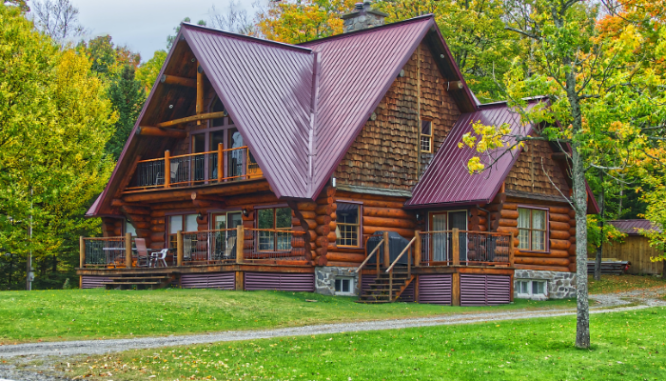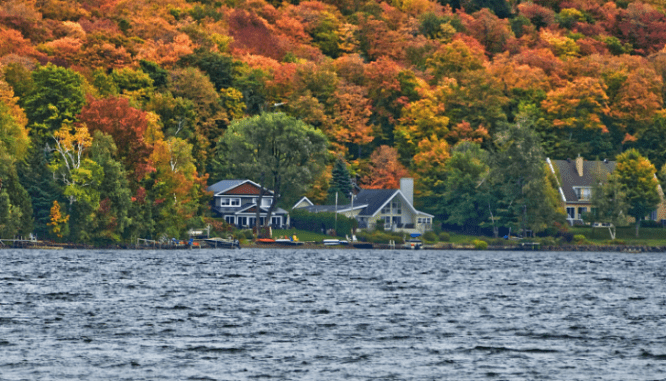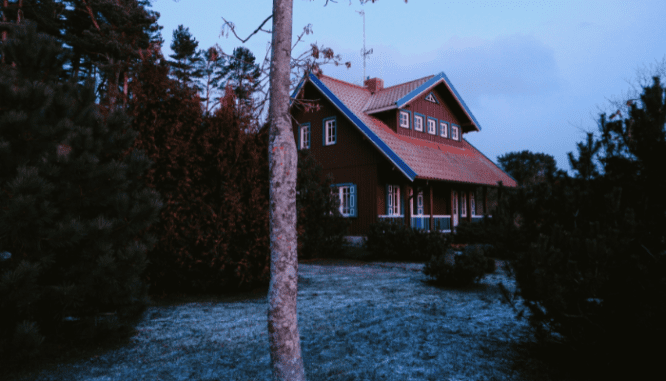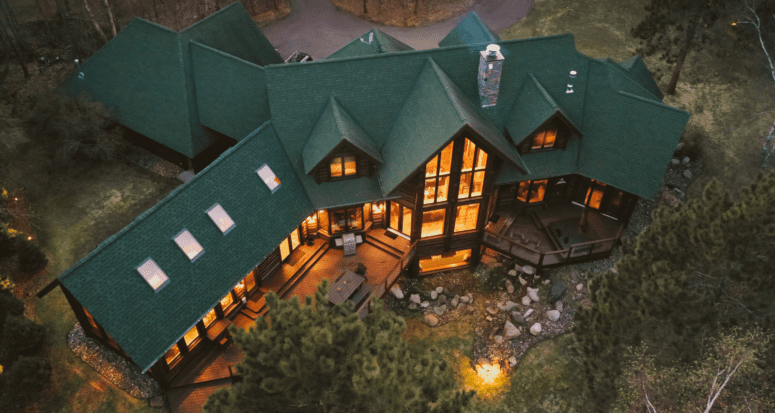Why a House Surrounded by Trees Might be Too Shady: Fire Risk, Falling Limbs, and No Grass
- Published on
- 5 min read
-
 Sandy John Contributing AuthorClose
Sandy John Contributing AuthorClose Sandy John Contributing Author
Sandy John Contributing AuthorSandy John is a freelance writer and editor who specializes in real estate, homeownership, and personal finance articles. Previously the real estate editor for The Atlanta-Journal Constitution, her byline has appeared in several national and regional publications. Sandy has purchased homes in four cities and she has lost track of how many DIY home-improvement projects she’s done.
Do you picture your dream home as a house surrounded by trees? Maybe you envision a Northwoods-style cabin enveloped by towering pines, or a home with multiple decks where you can reach out and touch the oaks, giving you the feeling of living in a treehouse.
“Trees are very desirable for buyers,” notes Paul Ertel, a real estate agent in Northern Idaho. He has worked with over 77% more single-family homes than the average agent in his market. Coeur d’Alene, Idaho, has streets lined with 100-year-old trees, and those neighborhoods appeal to buyers. Ertel and his wife, real estate agent Cindy Ertel, caution their buyers that trees need care and maintenance.
Buying a home surrounded by trees also comes with risks, and it’s best to be aware of them before buying. With lots of trees close to the house, you face the potential for a tree falling on your roof during a storm, roots damaging your foundation, and a constant battle to get grass to grow in your yard.
To give you a realistic view of issues you may encounter by owning a house surrounded by trees, we’ve talked to real estate agents in a woodsy area, reviewed information from the Forestry Service and other experts, and checked out the costs of caring for trees.

Falling trees and limbs
If you’ve seen pictures from hurricanes, tornadoes, or even ice storms, you know that trees can be uprooted and crash to the ground — or through the roof of the nearest house.
Trees can fall in any strong wind, in a process called “windthrow.” The wind essentially turns the tree trunk into a giant lever, pushing the top of the tree down and the roots up. The taller the tree, the more susceptible it is to windthrow, David R. Foster, a plant specialist with Harvard University, told Scientific American.
Trees may also fall in the wind because they developed a weak spot from a past injury, or because their roots were been damaged by construction equipment.
Even if entire trees don’t fall, branches dropping from trees can be destructive. A falling limb can hit property like your house or car — or worse, a person — with hundreds of pounds of force, causing severe damage. They can also take out utility lines, inconveniencing you and your neighbors. Even small branches can dent your vehicle if they drop from high up.
Roof damage and mosquitoes
Trees don’t have to fall on your house or drop limbs on it to cause damage.
Branches growing over your house can damage the roof. Possible sources of roof damage include:
- Low-hanging branches that scratch or rub the shingles, peeling away the protective layer.
- Overhanging branches that drop leaves on the roof. The leaves will flow into the gutters, clogging them and raising the risk of water damage. In northern areas, clogged gutters also increase the chances of ice dams.
- Branches that touch the house provide an avenue for rodents like squirrels to reach your roof, where they may decide to build a nest.
When overhanging branches clog your gutters, they also create an attractive spot for mosquitoes to lay eggs, creating an insect problem.

Foundation damage
When a tree grows too close to a house, its roots can damage the foundation, and the costs to repair that damage can accrue to thousands of dollars, according to the Michigan State University Extension Service.
The International Association of Certified Home Inspectors points to three ways that tree roots can damage a foundation:
- Tree roots can find an existing crack in the foundation. As they grow, the roots can widen the crack and grow through the foundation.
- Roots can grow under the house, lifting the foundation.
- As roots pull in groundwater from around or beneath the foundation, they can cause the foundation to settle unevenly, which can cause cracks.
Inspectors may also find roots that have grown into sewer lines, breached outdated clay sewer pipes, or lifted and damaged sidewalks and driveways, Paul Ertel says.
In instances where a home inspector says a tree is too close to the foundation or has branches overhanging the roof, the Ertels recommend asking the seller to remove the tree as part of the inspection negotiations.
“It is a safety concern,” Paul Ertel says, adding that sellers usually recognize they have to fix the issue — because if the current offer falls through, the next potential buyer will ask for the same thing.
How close is too close to a house?
Determining whether a tree is growing too close to the house is relatively easy if you’re judging by the branches. If large limbs are touching the building or roof, it’s likely too close.
It’s trickier to determine if the roots of a tree are too close to your foundation. Different types of trees may have different sized root balls, and growing conditions also affect the size.
Virginia Tech’s forestry department provides some common rules of thumb for estimating root size:
- The root system is two to three times as wide as the widest branches on the tree.
- The roots extend about 1.5 times the height of the tree.
Applying those guides, you can figure the roots on a 30-foot tree go out 45 feet in all directions. If the spread of the tree branches is about 20 feet, the roots could extend 40 to 60 feet. Both estimates suggest that large trees should be located a good distance from a home to limit possible damage.
The problem comes about because people don’t plant large trees; they plant saplings. They end up putting the tiny tree close to the house, forgetting that a small tree will grow to a stately height, with a root system and branches that need much more room than has been provided.
Too much shade?
Lounging in the shade on a hot day is a simple pleasure, but with lots of trees surrounding your house, you may find you have too much shade.
A yard filled with large, leafy trees may hinder your ability to do other things you might want to do on your property, including:
- Grow a lawn. Grass has a tough time growing in deep shade, and grass that does grow may be more prone to disease.
- Install a pool. Trees can drop leaves, nuts, and other debris into a pool. And most people prefer a sunny pool.
- Use solar panels. Trees can block sunlight from reaching your solar panels and reduce their effectiveness. At the very least, you’ll have to be aggressive about keeping the branches trimmed if you want to use solar energy.
- Use satellite TV. Large branches may limit where the satellite dish can be installed or disrupt your reception during windy weather.
Other problems
In scenic areas, such as Northern Idaho, trees that grow too large can obscure a view of a lake or mountains. Some communities have “view easements” that limit the height of buildings and trees, Paul Ertel says.
Such restrictions aren’t common, but it’s important for buyers to read the homeowners association covenants, conditions, and restrictions (CC&Rs) for the neighborhood they’re buying into (if applicable) to ensure the trees aren’t in violation.
In an area prone to wildfires, trees that are close to a house are also a fire hazard. The danger is even greater if the trees haven’t been maintained; dead trees and branches can provide easy fuel for the fire.
Even healthy trees are messy, dropping leaves, nuts, and seeds all over your property. Do you want to spend hours raking or using the leaf blower for several weekends each autumn?

Inspections and insurance
If you have your heart set on a house surrounded by trees, have a certified arborist perform an inspection before you buy. It’s an extra expense, although some tree-clearing companies have an arborist on staff who provides consultation at a reduced price, perhaps under $100, according to Angi.com (formerly Angie’s List.)
The average cost for cutting and removing a tree depends on how tall the tree is and how hard it is to reach. The price may range from $200 for a small tree to around $1,800 for an 80-foot tree. Removing the stumps costs extra, with stump grinding starting at about $100.
The arborist will look for issues such as:
- Dead, dying, or diseased trees
- Weak spots in trees or branches
- Trees located too close to the house
- Roots impacting the foundation or driveway
The arborist can also suggest soil amendments and other ways to improve the trees’ health.
“In many cases, people don’t look at trees as something they need to care for,” Paul Ertel says, but he recommends having trees inspected annually and taking steps to maintain your trees’ health.
If you’re buying a heavily wooded property, make sure your new homeowners insurance policy will cover damage from trees, too. If the damage results from a storm or similar peril, you’re likely covered. But some policies won’t cover tree damage that results from negligence — such as if you haven’t maintained your tree by trimming off dead branches.
Trees are an attractive feature
Despite the risks and expense of large trees, there are still many reasons to want trees on your property. The Arbor Day Foundation reports that having mature trees in your yard can:
- Increase your home’s value
- Make the home more attractive to future buyers
- Reduce air conditioning costs
- Provide a feeling of privacy
- Reduce noise from neighbors and nearby roads
As long as you have the trees inspected before buying and commit to regular care and trimming, a home surrounded by trees can be a dream location.
Header Image Source: (Drew Dau / Unsplash)
